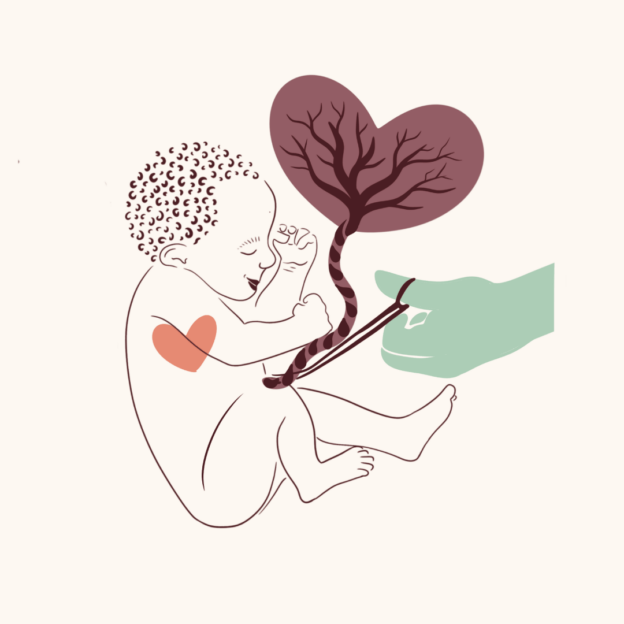Geschreven door Jiery van Roon
Gepubliceerd op 9 februari 2022
Laatste update 9 februari 2022
Na de geboorte van de baby is het kind nog steeds verbonden door de navelstreng. In de navelstreng zit dan nog bloed. De navelstreng kan worden doorgeknipt op verschillende momenten: direct na de geboorte van de baby, voordat de placenta geboren wordt, nadat de placenta geboren wordt (halve lotusgeboorte), of helemaal niet (volledige lotusgeboorte). Het doorknippen van de navelstreng heet ‘afnavelen’.
Wat gebeurt er als we de navelstreng laten uitkloppen? Wat is optimaal afnavelen? Hoe herkennen we een uitgeklopte navelstreng? En zijn er ook alternatieven voor het laten uitkloppen van de navelstreng? Dit artikel geeft antwoord op deze en andere vragen.
Andersson, O., Domellöf, M., Andersson, D., & Hellström-Westas, L. (2013). Effects of delayed cord clamping on neurodevelopment and infection at four months of age: a randomised trial. Acta Paediatrica, 102(5), 525–531. https://doi.org/10.1111/apa.12168
Andersson, O., Lindquist, B., Lindgren, M., Stjernqvist, K., Domellöf, M., & Hellström-Westas, L. (2015). Effect of delayed cord clamping on neurodevelopment at 4 years of age. JAMA Pediatrics, 169(7), 631. https://doi.org/10.1001/jamapediatrics.2015.0358
Andersson, O., & Mercer, J. S. (2021). Cord Management of the Term Newborn. Clinics in Perinatology, 48(3), 447–470. https://doi.org/10.1016/j.clp.2021.05.002 Andersson, O., Rana, N., Ewald, U., Målqvist, M., Stripple, G., Basnet, O., Subedi, K., & KC, A. (2019). Intact cord resuscitation versus early cord clamping in the treatment of depressed newborn infants during the first 10 minutes of birth (Nepcord III) – a randomized clinical trial. Maternal Health, Neonatology and Perinatology, 5(1). https://doi.org/10.1186/s40748-019-0110-z
Balasubramanian, H., Ananthan, A., Jain, V., Rao, S. C., & Kabra, N. (2020). Umbilical cord milking in preterm infants: a systematic review and meta-analysis. Archives of Disease in Childhood – Fetal and Neonatal Edition, 105(6), 572–580. https://doi.org/10.1136/archdischild-2019-318627
Boere, I., Roest, A. A. W., Wallace, E., Ten Harkel, A. D. J., Haak, M. C., Morley, C. J., Hooper, S. B., & Te Pas, A. B. (2014). Umbilical blood flow patterns directly after birth before delayed cord clamping. Archives of Disease in Childhood – Fetal and Neonatal Edition, 100(2), F121–F125. https://doi.org/10.1136/archdischild-2014-307144
Borlongan, C., Lawton, C., Acosta, S., Watson, N., Gonzales-Portillo, C., Diamandis, T., Tajiri, N., Kaneko, Y., & Sanberg, P. (2015). Enhancing endogenous stem cells in the newborn via delayed umbilical cord clamping. Neural Regeneration Research, 10(9), 1359. https://doi.org/10.4103/1673-5374.165218
Downey, C. L., & Bewley, S. (2012). Historical perspectives on umbilical cord clamping and neonatal transition. Journal of the Royal Society of Medicine, 105(8), 325–329. https://doi.org/10.1258/jrsm.2012.110316
Fuwa, K., Tabata, N., Ogawa, R., Nagano, N., Yamaji, N., Ota, E., & Namba, F. (2020). Umbilical cord milking versus delayed cord clamping in term infants: a systematic review and meta-analysis. Journal of Perinatology, 41(7), 1549–1557. https://doi.org/10.1038/s41372-020-00825-6
Gönenç, L. M., Aker, M. N., & Ay, E. (2019). Qualitative study on the experience of lotus birth. Journal of Obstetric, Gynecologic & Neonatal Nursing, 48(6), 645–653. https://doi.org/10.1016/j.jogn.2019.08.005
Hart Hayes, E. (2019). Placentophagy, lotus birth, and other placenta practices. Journal of Perinatal & Neonatal Nursing, 33(2), 99–102. https://doi.org/10.1097/jpn.0000000000000402
Jain, R., Jain, A., Devgan, V., & Sekhar, J. (2018). Effect of alternative positions of neonates prior to delayed cord clamping on placental transfusion: a randomized control trial. The Journal of Maternal-Fetal & Neonatal Medicine, 33(9), 1511–1516. https://doi.org/10.1080/14767058.2018.1520834
Jeevan, A., Ananthan, A., Bhuwan, M., Balasubramanian, H., Rao, S., & Kabra, N. S. (2021). Umbilical cord milking versus delayed cord clamping in term and late-preterm infants: a systematic review and meta-analysis. The Journal of Maternal-Fetal & Neonatal Medicine, 1–11. https://doi.org/10.1080/14767058.2021.1884676
Katheria, A., Reister, F., Essers, J., Mendler, M., Hummler, H., Subramaniam, A., Carlo, W., Tita, A., Truong, G., Davis-Nelson, S., Schmölzer, G., Chari, R., Kaempf, J., Tomlinson, M., Yanowitz, T., Beck, S., Simhan, H., Dempsey, E., O’Donoghue, K., . . . Cutter, G. (2019). Association of umbilical cord milking vs delayed umbilical cord clamping with death or severe intraventricular hemorrhage among preterm infants. JAMA, 322(19), 1877. https://doi.org/10.1001/jama.2019.16004
Li, J., Yang, S., Yang, F., Wu, J., & Xiong, F. (2021). Immediate vs delayed cord clamping in preterm infants: A systematic review and meta‐analysis. International Journal of Clinical Practice, 75(11). https://doi.org/10.1111/ijcp.14709
Liyanage, S. K., Ninan, K., & McDonald, S. D. (2020). Guidelines on Deferred Cord Clamping and Cord Milking: A Systematic Review. Pediatrics, 146(5). https://doi.org/10.1542/peds.2020-1429 McDonald, S. J., Middleton, P., Dowswell, T., & Morris, P. S. (2013). Effect of timing of umbilical cord clamping of term infants on maternal and neonatal outcomes. Cochrane Database of Systematic Reviews. https://doi.org/10.1002/14651858.cd004074.pub3
Mercer, J. S., & Erickson-Owens, D. A. (2012). Rethinking placental transfusion and cord clamping issues. Journal of Perinatal & Neonatal Nursing, 26(3), 202–217. https://doi.org/10.1097/jpn.0b013e31825d2d9a
Mercer, J. S., Erickson-Owens, D. A., Deoni, S. C., Dean, D. C., Collins, J., Parker, A. B., Wang, M., Joelson, S., Mercer, E. N., & Padbury, J. F. (2018). Effects of Delayed Cord Clamping on 4-Month Ferritin Levels, Brain Myelin Content, and Neurodevelopment: A Randomized Controlled Trial. The Journal of Pediatrics, 203, 266–272.e2. https://doi.org/10.1016/j.jpeds.2018.06.006
Mercer, J. S., Erickson-Owens, D. A., Deoni, S. C., Dean III, D. C., Tucker, R., Parker, A. B., Joelson, S., Mercer, E. N., Collins, J., & Padbury, J. F. (2020a). The Effects of Delayed Cord Clamping on 12-Month Brain Myelin Content and Neurodevelopment: A Randomized Controlled Trial. American Journal of Perinatology, 39(01), 037–044. https://doi.org/10.1055/s-0040-1714258
Mercer, J. S., Erickson-Owens, D. A., Deoni, S. C., Dean III, D. C., Tucker, R., Parker, A. B., Joelson, S., Mercer, E. N., Collins, J., & Padbury, J. F. (2020b). The Effects of Delayed Cord Clamping on 12-Month Brain Myelin Content and Neurodevelopment: A Randomized Controlled Trial. American Journal of Perinatology, 39(01), 037–044. https://doi.org/10.1055/s-0040-1714258
Moberg, K., Uvnäs-Moberg, K., & Boer, A. M. (2007). De Oxytocine factor. Thoeris. NVOG. (2013). NVOG-richtlijn Spontane vaginale baring. Nederlandse Vereniging voor Obstetrie en Gynaecologie. https://www.nvog.nl/wp-content/uploads/2018/02/Spontane-vaginale-baring-2.0-14-11-2013.pdf
Ortiz‐Esquinas, I., Rodríguez‐Almagro, J., Gómez‐Salgado, J., Arias‐Arias, N., Ballesta‐Castillejos, A., & Hernández‐Martínez, A. (2020). Effects of cord milking in late preterm infants and full‐term infants: A systematic review and meta‐analysis. Birth, 47(3), 259–269. https://doi.org/10.1111/birt.12500
Rabe, H., Diaz-Rossello, J. L., Duley, L., & Dowswell, T. (2012). Effect of timing of umbilical cord clamping and other strategies to influence placental transfusion at preterm birth on maternal and infant outcomes. Cochrane Database of Systematic Reviews. https://doi.org/10.1002/14651858.cd003248.pub3
Rabe, H., Gyte, G. M., Díaz-Rossello, J. L., & Duley, L. (2019). Effect of timing of umbilical cord clamping and other strategies to influence placental transfusion at preterm birth on maternal and infant outcomes. Cochrane Database of Systematic Reviews, 2019(9). https://doi.org/10.1002/14651858.cd003248.pub4
Tricarico, A., Bianco, V., Di Biase, A. R., Iughetti, L., Ferrari, F., & Berardi, A. (2017). Lotus birth associated with idiopathic neonatal hepatitis. Pediatrics & Neonatology, 58(3), 281–282. https://doi.org/10.1016/j.pedneo.2015.11.010
Vain, N. E., Satragno, D. S., Gorenstein, A. N., Gordillo, J. E., Berazategui, J. P., Alda, M. G., & Prudent, L. M. (2014). Effect of gravity on volume of placental transfusion: a multicentre, randomised, non-inferiority trial. The Lancet, 384(9939), 235–240. https://doi.org/10.1016/s0140-6736(14)60197-5
Welsh, S., Elwell, J., Manister, N. N., & Gildersleeve, R. K. (2020). Implementing delayed umbilical cord clamping in cesarean birth using a novel method: A pilot study of feasibility and safety. Journal of Midwifery & Women’s Health, 65(1), 109–118. https://doi.org/10.1111/jmwh.13075
WHO. (2014). Guideline: Delayed umbilical cord clamping for improved maternal and infant health and nutrition outcomes. Genève: World Health Organization. https://apps.who.int/iris/bitstream/handle/10665/148793/9789241508209_eng.pdf?ua=1
WHO. (2019, september). Essential nutrition actions. Genève: World Health Organization. https://www.who.int/publications/i/item/9789241515856
Wickham, S. (2021, 14 september). Optimal cord clamping: what’s the evidence? Dr Sara Wickham. Geraadpleegd op 23 januari 2022, van https://www.sarawickham.com/research-updates/optimal-cord-clamping/
Xodo, S., Xodo, L., Baccarini, G., Driul, L., & Londero, A. P. (2021). Does Delayed Cord Clamping Improve Long-Term (≥4 Months) Neurodevelopment in Term Babies? A Systematic Review and a Meta-Analysis of Randomized Clinical Trials. Frontiers in Pediatrics, 9. https://doi.org/10.3389/fped.2021.651410
YAO, A. (1969). Distribution of blood between infant and placenta after birth. The Lancet, 294(7626), 871–873. https://doi.org/10.1016/s0140-6736(69)92328-9 Zinsser, L. A. (2018). Lotus birth, a holistic approach on physiological cord clamping. Women and Birth, 31(2), e73–e76. https://doi.org/10.1016/j.wombi.2017.08.127
>

Reacties
Je moet inloggen om een reactie te kunnen plaatsen.



Zijn er bij laat afnavelen (in een klinische setting) gevolgen voor de baby wanneer er medicatie post partum toegediend wordt bij moeder. Bijvoorbeeld syntocinon of nalador? Iets om rekening mee te houden of geen probleem?
Dat weten we niet, daarover zijn de meningen verdeeld. Op het moment dat de placenta los ligt sowieso niet natuurlijk, dan is er geen verbinding meer met de moeder. Als de placenta nog vastzit: 2 experts (Kerstin Uvnas-Moberg en Sarah Buckley) zijn hier tegenstrijdig over, de 1 zegt dat het niet direct bij de baby komt, de ander van wel. Ik weet ook niet in hoeverre er nog een uitwisseling is tussen moeder en placenta als het kind geboren is.